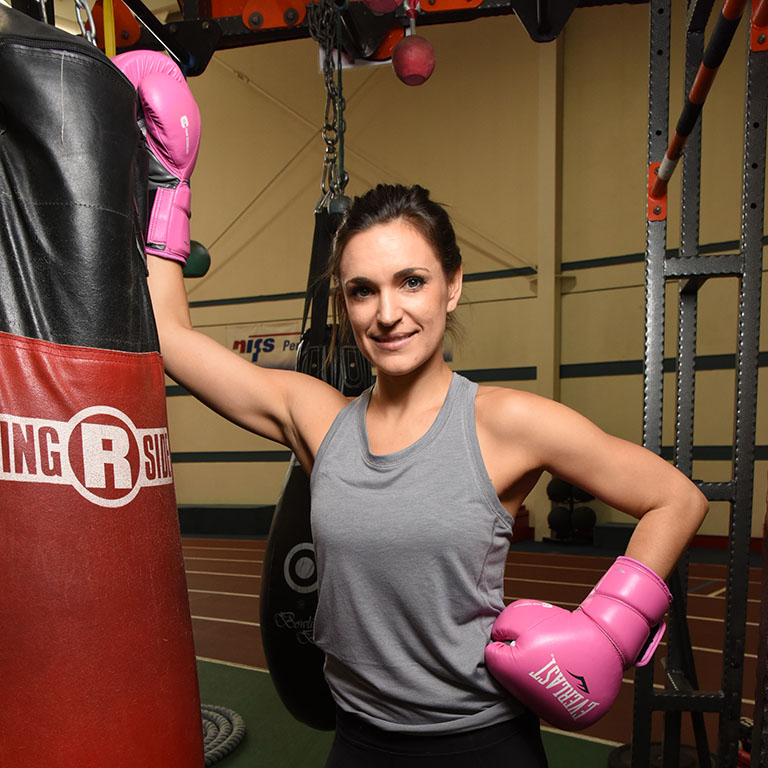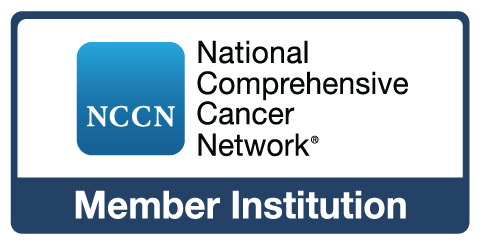INDIANA ELKS and IU SCHOOL OF MEDICINE
Creating Healthier Lives

Research funded by the Indiana Elks helps cancer patients survive and thrive
REPORT TO THE INDIANA ELKS 2020
Creating Healthier Lives for Cancer Patients
Like many brides, Ivy Stubbs prepared for her wedding in August 2018 by being extra attentive to her weight and appearance. By the time her big day arrived, she was lean and fit.
After the wedding, she relaxed for a bit before resuming her workouts—motivated by a honeymoon trip which was scheduled for late October. “I was feeling pretty great,” Stubbs said. “I was starting to work out really hard again.”
But as her trip neared, Stubbs received some devastating news: she had breast cancer. The trip came a week before her first treatment, a grueling 18-month stretch that left her feeling nothing like herself.
The treatment sapped her strength and caused her to gain 40 pounds over the next year. As she recovered, she tried to get back in shape. But her stamina failed her. That led her to pour out her frustration to her oncologist, Tarah Ballinger, MD. “When I was sick, I was skinny,” Stubbs recalled telling her. “And now that I’m healthy, I’m big.”
Helping women like Stubbs reclaim their lives after cancer is a focus of Ballinger’s research at the Indiana University Melvin and Bren Simon Comprehensive Cancer Center. The payoff is better physical, mental, and emotional health.
In her clinic, Ballinger continually encourages patients to establish exercise routines. But some women need help to make this happen.
“An oncologist has to be engaged in the process to get patients to exercise,” said Ballinger, an assistant professor of clinical medicine at IU School of Medicine. “But the step beyond that is referring patients to an actual program where they get personalized plans and carry it out.”
Ballinger helped launch such a program in Indianapolis. Cancer survivors who enroll receive a personalized exercise plan and attend three sessions a week over three months. Data is collected to help Ballinger assess changes to the intensity of the long-term side effects of therapy as the women recover and gain back strength and stamina.
Ivy Stubbs embodies the type of woman who signs up for this program.
While Stubbs felt fit before her diagnosis, the treatment Ballinger prescribed “threw the kitchen sink” at her. She received infusions of four chemotherapy drugs over six months, followed by six more months of hormonal chemotherapy. A drug she took for a year robbed her of her ability to taste and made her nauseous. And following a mastectomy, she endured seven weeks of radiation therapy.
When she wasn’t aching or experiencing numbness in her toes from neuropathy caused by the treatments, Stubbs fought to keep food down. Her workouts were modest: walking around the house or climbing the stairs. “It felt like my body was trying to eat itself,” she recalled. “I was in pain all the time.”
Laid up and recovering after her mastectomy, Stubbs’ appetite finally returned. Friends and family swung by and dropped off comfort food. She happily indulged. “It was my reward,” Stubbs recalled.
By year’s end, though, Stubbs noticed her weight on the scale. And when Ballinger prodded her about hitting the gym, Stubbs didn’t get upset with her doctor. Instead, she was frustrated with herself.
“It was hard to walk,” Stubbs said. “It was hard to put on clothes. It was hard to take a shower. I felt very weak and very insecure.”
So, in February, Stubbs signed up for Ballinger’s fitness program. After her assessment, she began a straightforward regimen. The first 20 minutes of a workout focused on cardio, either on a stationary bike, treadmill, or elliptical machine. Next, a trainer kept close watch as Stubbs moved through a weight routine. When she paused, her heart rate, blood pressure, and other vital metrics were recorded.
The pounds didn’t melt away, but Stubbs said a month of workouts left her feeling healthier and more energetic. She would still be churning through her sessions if the coronavirus pandemic had not forced the closure of gyms.
Still, Stubbs hasn’t let the shuttering of the gym stop her. Five days a week, she sweats through a 30-minute workout alongside her husband. The routine is different, but she wants the habit to endure. After each workout, she says a welcome feeling settles over her.
“I’m getting back to being me,” Stubbs said.
Thanks to support from the Indiana Elks, IU researchers will better understand how to help cancer patients get back to being themselves through exercise.
Exercise has always been a huge part of life for Tarah Ballinger, MD
In college, she captained the women’s boxing team. She has worked as a personal fitness trainer. For her, a session at the gym is a release for the inevitable stress of the workday.
“Exercise has helped me in terms of my own determination,” said Ballinger, a breast oncologist at the Indiana University Melvin and Bren Simon Comprehensive Cancer Center. “And I always wanted to apply something I think is important into my job.”

While Ballinger consistently recommends exercise to her patients, she knows that the body of literature on the topic is modest. Recognizing that physicians typically lack formal guidance about how to integrate physical activity into a tailored treatment plan, Ballinger found this to be a natural area for research.
Studies have long shown exercise can ease the neuropathy, sleep deprivation, and anxiety that come with chemotherapy. Some preclinical data also suggests working out alters the blood supply to tumors, thereby enhancing the delivery of chemo drugs.
That said, many breast cancer patients and survivors are physically inactive. The recommendation oncologists make for physical activity mirrors one for the general public: 150 minutes of moderate or vigorous activity each week. But patients may not know how to make exercise part of their daily routine.
“A lot of times, I hear patients say, ‘Being sedentary is my new baseline,’” Ballinger said. “We shouldn’t really accept that, and we need to intervene more.”
That reality dawned on Ballinger two years ago. Back then, she was conducting a study asking whether chemotherapy or anti-estrogen drugs impacted a woman’s fitness level during treatment. Ballinger expected chemo to exact a higher toll. “That didn’t happen at all,” Ballinger said. Instead, her results showed both groups suffered a decline, and neither bounced back quickly.
Ballinger also wondered whether it was possible to deliver personalized workout plans to women. So, she outfitted patients with GPS-enabled watches, tracked their movements, and gave each a unique regimen. Researchers designed the exercise to be done at home, removing the obstacle of going to a gym or paying for a trainer.
The results were promising. “It made a big difference, especially in the most deconditioned patients,” she said. “We can use that as sort of a springboard to get patients into more intensive exercise.”
Those early findings set the stage for new research moving forward. One study would pair a breast cancer survivor with a trainer who will guide the woman through exercise designed to ease the long-term side effects of treatment. A second study calls for women who are not exercising to receive workouts via their GPS watch, build up their conditioning over six months, and then transition to a more structured program.
Often, philanthropic support is associated with funding early breakthroughs in a laboratory or taking a drug into a clinical trial. But such support can also enable researchers like Ballinger to test more holistic approaches to improving the lives of cancer patients.
“The great thing about physical activity is that it’s relatively free,” Dr. Ballinger said. “Physical fitness is never not helpful, but the question is, how can we better help patients participate in their treatment in a way that’s meaningful?”
Thanks to the generosity of the Indiana Elks, Ballinger is poised to answer this question and help many women get up and moving again.

Dear Friends,
As the interim division director of the Indiana University School of Medicine Division of Hematology/Oncology, I am pleased to share this year’s update with the Indiana Elks. While I have not had the pleasure of personally meeting many of you, please know that your reputation precedes you. I am well aware of your decades of generosity to IU cancer research. Thank you.
I am truly sorry that the circumstances of the pandemic prevented Dr. Tarah Ballinger from presenting to your state convention this year. She exemplifies the type of bright young researcher that Indiana Elks funding supports. Dr. Ballinger completed her fellowship training here at IU School of Medicine and – thanks to generous donors like the Indiana Elks – we are able to retain her and provide support to get her research career up and running. Thank you for helping make that possible.
We are deeply appreciative of the support the Indiana Elks provide annually to cancer research at Indiana University, and we look forward to a time when we can express our gratitude in person. Until then, please be safe and stay well.
Gratefully yours,
Rakesh Mehta, MD
Associate Professor of Clinical Medicine
Interim Division Director, Division of Hematology/Oncology
Department of Medicine
Indiana University School of Medicine




